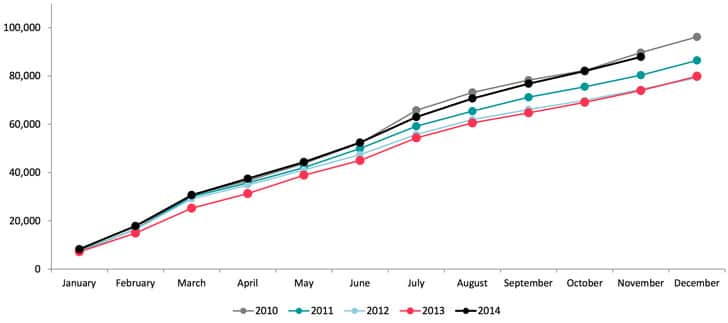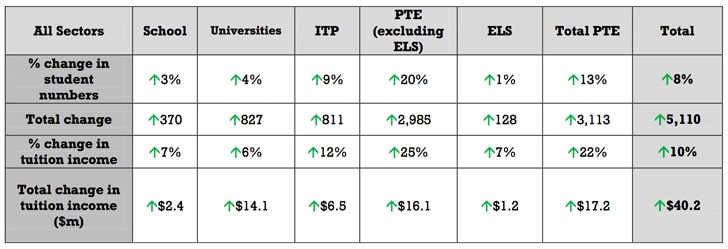New Zealand continues to build on 2013 enrolment growth
After years of flat or declining international enrolment, New Zealand began to turn the corner in 2013. More specifically, after a tough start to the year - which saw January to April enrolment fall off by 5% compared to the same period in 2012 - the country began to make some modest gains with foreign student numbers increasing 4% from May to August and another 2% from September to December.
And now, as 2014 draws to a close, those promising indicators from last year are looking more and more like the start of a longer-term trend.
While detailed statistics for the full year are not yet available, the January to April international enrolment figures have been published and they show an increase of 8% over the same period for 2013. Separately, Immigration New Zealand’s reporting on student visas issued show that the country issued 19% more student visas year-to-date through November as compared to the same period in 2013. Both trends bode well for New Zealand’s stated ambition to double the economic impact of its international education sector from NZ$2.6 billion today to NZ$5 billion by 2025. Education New Zealand has estimated that the sector will need to grow by an average of 5% per year in order to reach that 2025 target. If that’s the case, then the growth projected for 2014 will be a great step towards the country’s strategic enrolment and economic impact goals.
Counting visas
The Immigration New Zealand (INZ) data provides a valuable window on enrolment trends in the country, especially as it is very timely, with only about a one-month lag between the point at which a visa is issued and the point at which INZ publishes its visa counts. However, there are a couple of important cautions that accompany the immigration statistics, most notably the following:
- The INZ student visa figures do not reflect students arriving in New Zealand for shorter-term studies - of three months or less - and so enrolment in English language programmes (and some other private training programmes) will tend to be understated in immigration reporting.
- Issuance of student visas does not correlate precisely to enrolment as there may be a lag of some months between the point at which a student receives a visa and the point at which s/he arrives in New Zealand to begin studying. Conversely, returning students may conclude, abandon, or interrupt their studies during the term of a renewed visa and any such withdrawals will create a further discrepancy between total visa numbers and actual enrolment.
With those constraints firmly in mind, Education New Zealand draws on the INZ data to report the following highlights for the first 11 months of 2014.
- The total number of student visas approved was up by nearly 20% year-to-date (YTD) for a total of 13,896 more visas issued compared to the same period for 2013.
- India has proven to be a major growth driver for New Zealand with 78% more student visas issued YTD in 2014, and a 122% bump in first-time student visas for Indian students.
- Enrolment from ASEAN markets and Latin America were up sharply as well, 13% and 50% respectively.
- As of July 2014, enrolment from India and Latin America had already exceeded the student visas issued for each in 2013.
In an interesting departure from last year’s trend for the private training establishment (PTE) sector - where enrolment was essentially flat overall in 2013 - visas issued to foreign students enrolled at PTEs are up sharply at 84% YTD.
As the following chart illustrates, the total numbers of student visas issued month-by-month for 2014 is on pace to meet, if not exceed, the recent-year highs recorded in 2010.

Checking actual enrolment
It will be interesting to see how the YTD visa issuance stats compare to actual enrolment for the full year when Education New Zealand publishes its complete annual tracking report for 2014. For the moment, the interim report for the first trimester - that is, for January to April - shows an 8% gain over the same period in 2013. This represents an increase of 5,110 additional international students for the first four months of the year. The lion’s share of the growth in early 2014 was driven by India (+41%, 2,996 students), and China (12% growth, 2,122 students).
However, new students from the two countries tend to choose distinct study paths in New Zealand.
Virtually all of the Indian growth was targeted to programmes with non-English language private training establishments (PTEs, 2,601 more students in 2014) and institutes of technology and polytechnics (ITPs, 403 more students). In contrast, Chinese enrolment growth was largely directed to the university sector (15% growth, 1,063 more students in 2014) and the school sector (22% growth, 581 more students).
As the following table reflects, these two national groups had a profound impact on the overall growth by sector across the New Zealand system.

Most Recent
-
ICEF Podcast: Engine of growth: The true value and impact of the international education sector Read More
-
Global higher education enrolments expected to grow through 2035, but new challenges must be addressed Read More
-
Canada: A case study of immigration policy impacts on postsecondary institutions and the wider economy Read More
















